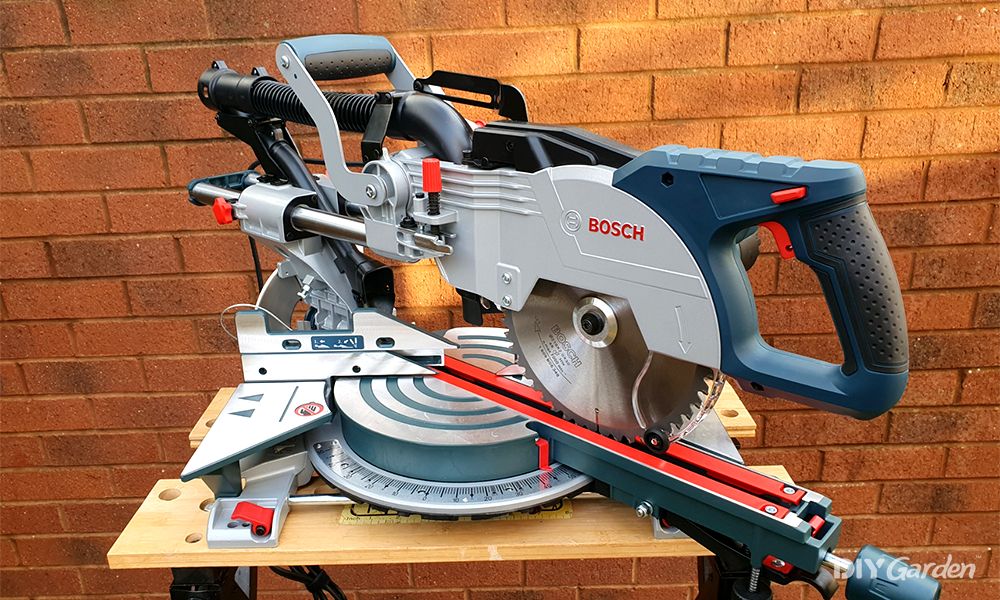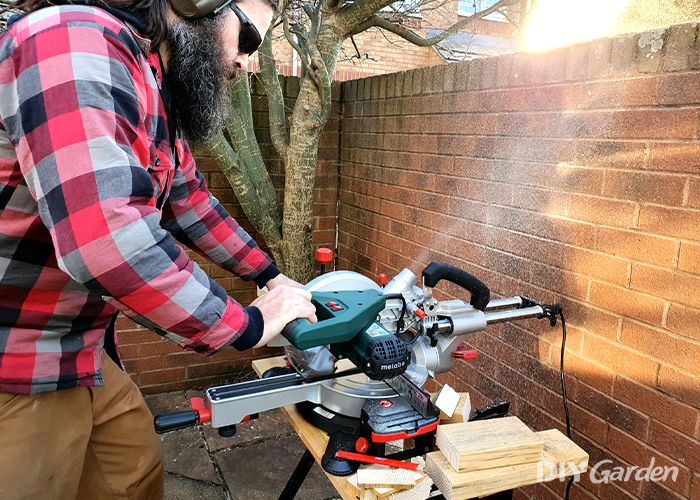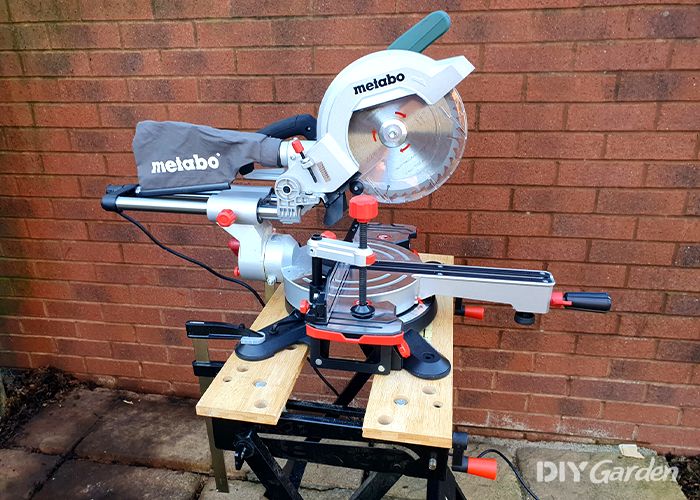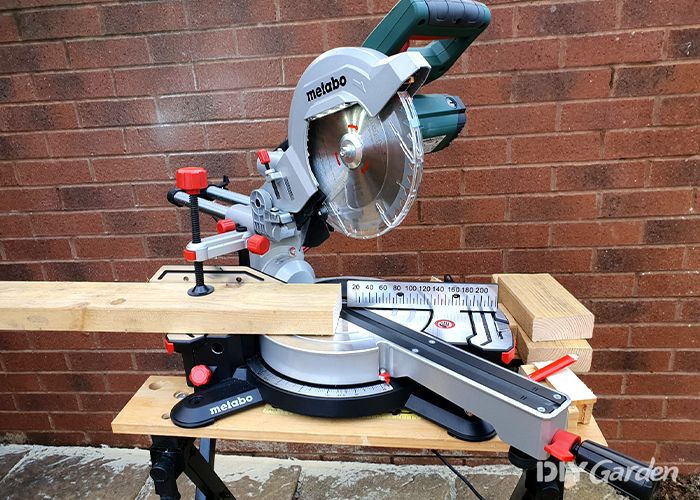I was blown away by the capacity of this Metabo chop saw. It’s quite remarkable what you can cut with just a 216 mm blade thanks to the enormous sliding rail on this tool. It does come with a few problems, however. The sliding section is almost comically oversized, it sticks out the back of the saw so much that you’d need a huge workbench to fit it on.
Like the Bosch GCM8SJL, I would struggle to live with such a big saw in my small shed. The footprint is too big for me, so I’m forced to use it outside on my folding bench. If space isn’t an issue for you, then this is a perfectly good workshop saw that is also just about portable enough.
My overall impression from using the Metabo KGS216M Sliding Mitre Saw for a few weeks is that it’s good at what it does. However, if I was planning to do a lot of work and push my mitre saw to the limit, I’d spend the extra money and get the rock-solid Bosch GCM8SJL.
READ NEXT:
- Best Circular Saw Review
- Best Mini Circular Saw Review
- Best Table Saw Review
- Best Jigsaw Review
- Best Reciprocating Saw Review
- Best Band Saw Review
- Best Dust Extractor Review
INDIVIDUAL MITRE SAW REVIEWS:
Metabo KGS216M Sliding Mitre Saw[ SAVE 4% ]

- Design
- 3.5
- Performance
- 4
- Power
- 4
- Noise
- 3
- Safety
- 4
- Value for Money
- 4
- Bevel
- Single
- Power
- Mains - 1,500W
- Blade Speed
- 5,000rpm
- Blade Diameter
- 216mm
- Max Cut 90x90°
- 305 x 65mm
- Max Cut 90x45°
- 305 x 36mm
- Max Cut 45x90°
- 205 x 65mm
- Max Cut 45x45°
- 205 x 36mm
- Weight
- 13.5kg
One of the big names in professional woodworking tools, German firm Metabo have a long history of excellence. Their range of mitre saws is impressive, and their KGS216M fits somewhere between their ultra-portable small saws and extremely capable high-capacity benchtop workhorses. It’s not a huge mitre saw, but thanks to a large sliding section it can cope with surprisingly bit bits of timber.
How I Tested
Read our product testing methodology here.
The main job of a mitre saw is to make accurate and repeatable cuts at a range of angles into a workpiece. To test each saw side-by-side I made multiple crosscuts and mitre cuts into standard CLS timber at 0° and 45°. I also made a series of compound mitre cuts to test the accuracy of the bevel adjustment at 0° and 45° and checked it all with a trustworthy digital angle finder.
It’s not just about making accurate cuts though, as the best mitre saws are easy to use and feel right too. I paid close attention to how well the saw was put together, the accessories included to help with cutting like the laser and work light, and if it was comfortable to use over long periods.
The final test for each saw was to find out how easy or difficult adjusting the saw would be. No mitre saw comes adjusted perfectly from the factory, so it makes sense to tackle the adjustment screws and find out if getting it to cut right is a huge pain.
Design
Unboxing the Metabo KGS216M Sliding Mitre Saw was a fun process. It’s well packaged in a huge cardboard box, but unfortunately still uses polystyrene for packing rather than something a bit more sustainable. The manual, dust bag, handle, and guide rail extensions are all embedded in the top when you open the box. Everything’s well packaged and shouldn’t be easily damaged during delivery.
One of the big attractions of this saw for me is the excellent cutting capacity. With 305 x 65 mm at 0°, it’s big enough to tackle serious sizes of board thanks to the slide-out blade. The blade section slides smoothly on a pair of rails, which makes the most of the small 216 mm blade.
The only problem that comes with this enormous cutting capacity is the space you need behind the saw. If the supporting feet are flush with the back of a workbench, you’ll need at least 400 mm of clearance on the back side. It’s not a huge issue, but don’t confuse this with a compact jobsite chop saw.
One of the things that struck me about this saw was how intuitive the various knobs and buttons all are. They just make sense, so there was minimal head-scratching to work out what everything does. It’s a shame that all these knobs and levers are plastic and a bit bendy. If they had been made from a glass fibre reinforced plastic, I think they’d feel a bit stronger and probably last a bit longer.
You get a pair of table extensions that fit neatly onto the end of the saw bed, and the right-hand one has a flip-up stop on it. This will come in extremely handy for ganging up work if you need to cut multiple bits of timber to the same length.
Because of the sliding and bevelling features on this saw, Metabo have been forced to construct the fence in two pieces. The top half slides out of the way to allow the blade to pass by, but it means the fence is thin and a bit wobbly. Compared with the solid sliding fence on the Bosch GCM8SJL it’s not the best.
One of the benefits of Metabo not using such heavy gauge aluminium is the overall reduction in weight. Even though this saw takes up almost as much space, it’s much lighter than the Bosch. Coming in at 13.5 kg, it’s much easier to carry around using the big top handle.
Just like the DeWalt DWS774, the right side of the fence is etched with measurements from the centre of the blade. I checked the accuracy with a trusted ruler and it’s just about perfect. And Metabo have also coloured in the measurements with black paint on top of the etchings, so they’re a bit easier to read in direct sunlight.
Turning the saw table through 45° in either direction is lovely and smooth. I’m pleased that Metabo have included positive stops at all the common angles: 0°, 15°, 22.5°, 30° and 45° on both sides. The big red angle indicators make it easy to see exactly where you are as well.
The same goes for setting the bevel of the saw. The large red handle on the back is a piece of cake to use, and lets you set any angle between 0° and 45° easily and quickly. You can also nudge it over to 47° on one side and 2° on the other, by pulling out a red stopper on the back.
Whether you want to call them dadoes, trenches, or rabbets, you can easily set the saw to cut to a certain depth. On the left of the blade guard is a simple mechanism that slides back or forward to engage the stop, which is adjusted with a simple screw. I really like that the depth up to 60 mm is displayed above the stop for quick reference.
I’m not so keen on the big red locking lever that controls the tilt function though. I had trouble trying to tighten it up, and it would work itself loose too easily. You need to pull the lever out to work it around the bolt, then push it in to lock it into place. It’s a bit complicated compared with a standard plastic knob and would become irritating quickly if lots of angle changes were necessary.
To help you make accurate cuts and see what you’re cutting, Metabo have added both a work light and a laser to this mitre saw. They’ve got individual switches in case you want to use them independently of each other, which is a nice touch. The laser isn’t the strongest I’ve come across, but you can still see it outdoors in bright sunshine, and the LED light does a decent job as well when you’re indoors.
Performance

The first test of the performance of this mitre saw is to find out how well it came set up from the factory. The next challenge is finding out how easy it is to adjust the angles and the laser guide if it’s not perfectly set up.
I immediately came across a bit of a problem. Supplied with the saw is a hex key with a Philips head screwdriver on one end. This works if you want to adjust the fence or change the blade but manipulating the laser guide and angle indicators was another matter entirely.
To adjust the laser, you’ll need to undo a tiny grub screw with a hex key. Unfortunately, it’s a bit of an odd size at 2.5 mm, and I don’t have half sizes on my normal set. The next issue was when I tried to adjust the angle indicators. These are held in place with T20 size Torx head screws, which again aren’t included.
It’s rather annoying when manufacturers use so many different types and sizes of fixing on their tools. If they all used the same size hex bolt or crosshead screw, you wouldn’t need to fiddle around with different bits to get the saw to cut straight.
Luckily, the Metabo KGS216M saw was set up almost perfectly from the factory. Once I’d found the right size Torx and hex bits, it was easy to adjust everything to make it cut straight. Getting the laser to follow the angle of the saw blade accurately wasn’t too difficult either.
Running the saw and making lots of cuts into CLS was about as I expected. It spins up quickly and cuts timbers without complaining. It’s not the most powerful saw on my list so it doesn’t quite fly through the wood, but if I wasn’t making a direct comparison I’d hardly notice!
Setting the mitre angle to 45° is easy with the large front handle, but the tilt adjustment locking lever is slow to use. It cuts accurately enough though and the sliding function runs smoothly and doesn’t have any wobble to it.
Power
The 1,350 Watt motor in this chop saw isn’t the most powerful on my list, but it can still spin up the 216 mm blade up to a maximum 3,750 rpm under load. That’s no mean feat for this relatively small powerplant.
The relatively small motor on the KGS216M can still do the business. It’s not quite as fast at cutting as the big Bosch is, but unless you’re working with huge amounts of timber it doesn’t make all that much difference.
Noise
Rated for a sound power level of 104 dB, this saw makes about the same noise as a motorcycle engine. It’s not the loudest on my list, but it’s still up there with the biggest power tools. I wouldn’t dare use a mitre saw without wearing proper hearing protection. Prolonged exposure to anything over 100 dB can cause permanent hearing damage.
The quality of the noise this saw makes isn’t great, however. When you first pull the trigger there’s a grinding noise as the blade gets up to speed. It could be something to do with the motor brushes, but it doesn’t sound as professional as the DeWalt DWS774.
Safety
As far as I can tell so far, the Metabo KGS216M is about as safe as you can get with a mitre saw. The polycarbonate blade guard feels strong, and it’s locked in place unless you pull the big red safety lever. The thick instruction manual is filled with safety advice and step-by-step instruction on how to make each cut safely.
If there was one thing I’d take away from this saw, it’s those flimsy knobs and levers to control the mitre and bevel functions. If they end up breaking, some users might be tempted to carry on using the saw in an unsafe manner.
Value for Money
It’s hard to beat this saw when it comes to cutting capacity. It can take quite enormous pieces of timber, much larger than you’d expect from a saw with a small diameter blade. For this capacity alone, it’s worth the price of admission.
The Metabo KGS216M Sliding Mitre Saw is well put together, feels solid and should last for a long time as far as I can see. It’s not the heaviest duty mitre saw by a long way, but for the money, it’s one of the best mitre saws for DIYers available right now.
If your top requirements are being able to cut big bits of timber, and you don’t want to splash out quite as much cash for the Bosch Professional, this is the saw for you!
Overall
I was blown away by the capacity of this Metabo chop saw. It’s quite remarkable what you can cut with just a 216 mm blade thanks to the enormous sliding rail on this tool. It does come with a few problems, however. The sliding section is almost comically oversized, it sticks out the back of the saw so much that you’d need a huge workbench to fit it on.
Like the Bosch GCM8SJL, I would struggle to live with such a big saw in my small shed. The footprint is too big for me, so I’m forced to use it outside on my folding bench. If space isn’t an issue for you, then this is a perfectly good workshop saw that is also just about portable enough.
My overall impression from using the Metabo KGS216M Sliding Mitre Saw for a few weeks is that it’s good at what it does. However, if I was planning to do a lot of work and push my mitre saw to the limit, I’d spend the extra money and get the rock-solid Bosch GCM8SJL.
READ NEXT:
- Best Circular Saw Review
- Best Mini Circular Saw Review
- Best Table Saw Review
- Best Jigsaw Review
- Best Reciprocating Saw Review
- Best Band Saw Review
- Best Dust Extractor Review
INDIVIDUAL MITRE SAW REVIEWS:
Metabo KGS216M Sliding Mitre Saw[ SAVE 4% ]

- Design
- 3.5
- Performance
- 4
- Power
- 4
- Noise
- 3
- Safety
- 4
- Value for Money
- 4
- Bevel
- Single
- Power
- Mains - 1,500W
- Blade Speed
- 5,000rpm
- Blade Diameter
- 216mm
- Max Cut 90x90°
- 305 x 65mm
- Max Cut 90x45°
- 305 x 36mm
- Max Cut 45x90°
- 205 x 65mm
- Max Cut 45x45°
- 205 x 36mm
- Weight
- 13.5kg



Share